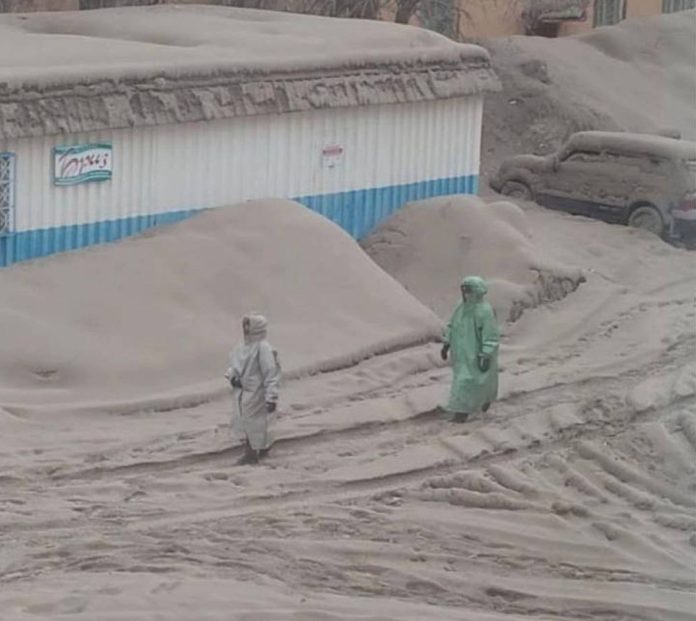A volcanic eruption of Shiveluch in Russia’s Far East has sent ash up into the stratosphere as high as 26,600 feet, according to the Kamchatka Volcanic Eruption Response Team.
The volcano has been restless for decades, spewing steam regularly. But explosions are now occurring continuously, and the suspended ash ultimately may impact aviation in Alaska.
Ash has covered 41,699 square miles of Russian territory, according to a report from the of the Russian Academy of Sciences Geophysical Survey, which reports it as the biggest ash fall in 60 years. The village of Klyuchi, 30 miles from the volcano, is covered with three inches of ash and is currently experiencing low visibility, the agency said.
Although Russia is off limits for international aircraft due to its war on Ukraine, Russian aircraft still will have to be wary of the hazards. It’s also likely the winds will push the ash plume to the east and over the Pacific Ocean, where it could become an international air traffic concern.
Shiveluch is a a steep-sloped volcano composed of alternating layers of solidified ash, hardened lava, and volcanic rocks, according to NASA. It is one of the peninsula’s most active volcanoes, with 60 substantial eruptions in the last 10,000 years. A major eruption of a volcano like this can have dramatic impact on weather, warming or cooling the climate down for years to come.
“When Indonesia’s Mount Tambora erupted in 1815, it unleashed the most destructive wave of extreme weather the world has witnessed in thousands of years. The volcano’s massive sulfate dust cloud enveloped the Earth, cooling temperatures and disrupting major weather systems for more than three years,” a researcher at the University of Illinois reports.

There has been concern about the phytoplankton in the Bering Sea. The volcanic ash from this eruption could give a boost to the plankton and thus the ecosystem. A study found volcanic ash can be a fertilizer to seawater.
T. J. Browing; H. A. Bouman; G. M. Henderson; T. A. Mather; D. M. Pyle; C. Schlosser; E, M. S. Woodward; C. M. Moore (2014). Strong responses of Southern Ocean phytoplanton communities to volcanic ash. Geophysical research Letters, Vol. 41, Issue 8. DOI:10.1002/2014GL059364
Natures deterrent to global warming
Only in the very short term.
Looks like the 1980 eruption of Mt. St. Helens. I wonder if commercial jet planes heading to the Far East or Hawaii from Anchorage will be affected?
Now would be a good time to probe Russian airspace like they do ours. Maybe we can get a couple of their military aircraft to suck up a bunch of ash and ruin their engines.
That which fits the goose fits the gander………
If that ash gets into electronics it will let the smoke out of the components and everyone knows there’s only so much smoke engineered into electronics. Once it’s out they’re done.
Will this plume add to earth temperatures? If our temps increase by 1.5 degrees, we die. We need to ban volcanoes, they’re worse than gas stoves.
It’s a great joke. Have fun with this
Suzanne, the reference to Mt Tambora and a Volcano’s ability to cause world wide climate change is true, but only if the Volcano is along the equatorial belt. Volcanos further North such as the one in this story have a far more limited effect worldwide.
The Katmi eruption in 1912 is a good example of this. It is considered to be the greatest eruption in recorded history and dumped ash far and wide, yet I don’t believe it caused any climate change beyond the region. According to my Great Grandmother the ash burnt my Grand Father’s diapers to a “crisp” in Valdez however. I’ve read that some 4 to 5 feet covered portions of Kodiak Island too.
With that in mind, why the push to limit wood and gas stoves in the north? They have no impact, right?
The people living in the area are going to be in rough shape. Like us, they already have a heavy snow load on their roofs. The combined weight of the very dense ash is liable to be too much. Hope they will be able to get help if needed.
A little research finds this interesting :
When Indonesia’s Mount Tambora erupted in 1815, it unleashed the most destructive wave of extreme weather the world has witnessed in thousands of years. The volcano’s massive sulfate dust cloud enveloped the Earth, cooling temperatures and disrupting major weather systems for more than three years. Communities worldwide endured famine, disease, and civil unrest on a catastrophic scale.
Tambora’s global and historical reach: how the volcano’s three-year climate change regime initiated the first worldwide cholera pandemic, expanded opium markets in China, and plunged the United States into its first economic depression. Bringing the history of this planetary emergency to life, Tambora sheds light on the fragile interdependence of climate and human societies to offer a cautionary tale about the potential tragic impacts of drastic climate change in our own century.
Current climate scare is just that ( a scare) it doesn’t tell us anything that history has documented, It’s now the fleecing of the worlds consumers / taxable sheep!
Another reason to appreciate the ongoing winter and snow fall. The snow should help purge the air. Let it snow!!!
Comments are closed.